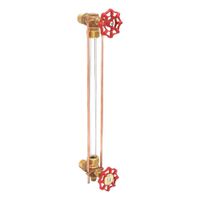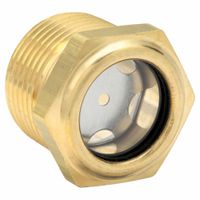Call +(254) 703 030 000 / 751 483 999 / 721 704 777
- Home
- Pumps
- Flow Level Measurement Controls
- Sight Glass Liquid Level Gauges
Sight Glass Liquid Level Gauges
Sight glass liquid level gauges visually indicate the volume of fluid left in a barrel, tank, or other liquid storage container. Tube-style liquid level sight glasses are cylindrical sights that mount to the outside of a container to monitor and show levels. Window-style sight glasses are single-pan .....Read More
Frequently Asked Questions
What is a sight glass liquid level gauge?
A sight glass liquid level gauge is a transparent tube or window installed on tanks, vessels, or pipelines to visually monitor the liquid level within. It provides a direct and real-time indication of the fluid level, allowing operators to assess the amount of liquid present without needing electronic sensors or complex instrumentation.
Typically made from materials like glass, acrylic, or polycarbonate, sight glasses are designed to withstand the pressure, temperature, and chemical properties of the contained liquid. They are often encased in metal frames for protection and durability. The sight glass is connected to the tank or vessel at two points, allowing the liquid to flow into the tube and rise to the same level as the liquid in the container, due to the principle of communicating vessels.
Sight glass liquid level gauges are used in various industries, including chemical processing, oil and gas, pharmaceuticals, and food and beverage, where it is crucial to maintain precise control over fluid levels. They are valued for their simplicity, reliability, and ease of maintenance.
There are different types of sight glass gauges, such as reflex, transparent, and magnetic. Reflex gauges use prismatic grooves to enhance visibility, while transparent gauges have two glass plates for viewing the liquid directly. Magnetic gauges incorporate a float with a magnet that moves with the liquid level, providing an indirect reading.
Despite their advantages, sight glass gauges have limitations, such as vulnerability to breakage and difficulty in reading levels in opaque or foamy liquids. Regular maintenance and inspection are necessary to ensure their accuracy and longevity.
How does a sight glass liquid level gauge work?
A sight glass liquid level gauge is a device used to visually monitor the level of liquid within a tank or vessel. It consists of a transparent tube or window, typically made of glass or durable plastic, that is mounted vertically on the side of the container. The sight glass is connected to the tank at two points: one at the bottom and one at the top, allowing the liquid to flow into the tube.
The principle of operation is based on the concept of communicating vessels. The liquid inside the tank seeks the same level in the sight glass as it does in the tank due to gravity and atmospheric pressure. As the liquid level in the tank changes, the level in the sight glass changes correspondingly, providing a direct visual indication of the liquid level.
The sight glass is often equipped with a scale or markings to facilitate easy reading of the liquid level. Some designs include protective shields or covers to prevent damage to the glass and enhance safety. In high-pressure or high-temperature applications, the sight glass may be made from specialized materials like borosilicate glass or quartz to withstand harsh conditions.
For enhanced functionality, some sight glasses are integrated with lighting for better visibility in low-light conditions, or with electronic sensors that provide remote monitoring capabilities. Maintenance involves regular cleaning to ensure clarity and checking for leaks or damage to the glass.
Overall, sight glass liquid level gauges are simple, reliable, and cost-effective tools for monitoring liquid levels in various industrial applications, including chemical processing, oil and gas, and water treatment.
What are the types of sight glass liquid level gauges?
There are several types of sight glass liquid level gauges, each designed for specific applications and operating conditions:
1. **Tubular Sight Glass Gauges**: These are the simplest form, consisting of a clear glass or plastic tube connected to the side of a tank. The liquid level inside the tube corresponds to the level in the tank. They are suitable for low-pressure and non-hazardous applications.
2. **Reflex Sight Glass Gauges**: These gauges use a prismatic glass that enhances visibility by reflecting light. The liquid level appears dark, while the empty part appears silvery. They are ideal for clear liquids and provide a clear distinction between liquid and gas phases.
3. **Transparent Sight Glass Gauges**: These have two transparent glass plates on either side of the chamber, allowing light to pass through. They are suitable for colored or opaque liquids and provide a clear view of the liquid level.
4. **Bi-Color Sight Glass Gauges**: These use two different colors to indicate the liquid and vapor phases, often red for vapor and green for liquid. They are used in high-pressure steam applications to enhance visibility and safety.
5. **Armored Sight Glass Gauges**: These are designed for high-pressure and high-temperature applications. They have protective metal casings to shield the glass from damage and are used in harsh industrial environments.
6. **Magnetic Sight Glass Gauges**: These combine a magnetic float with a sight glass, providing a visual indication of the liquid level. They are used in applications where direct contact with the liquid is not desirable.
Each type of sight glass gauge is selected based on factors such as pressure, temperature, fluid characteristics, and safety requirements.
How do you install a sight glass liquid level gauge?
1. **Preparation**: Ensure the system is depressurized and drained. Verify compatibility of the sight glass with the fluid and operating conditions.
2. **Select Location**: Choose a location that provides clear visibility and is easily accessible for maintenance. Ensure the gauge is level and aligned with the tank or vessel.
3. **Install Valves**: Attach isolation valves to the tank connections. These allow for maintenance without draining the tank. Use appropriate gaskets and sealants to prevent leaks.
4. **Mount Brackets**: Secure mounting brackets to the tank or vessel. Ensure they are aligned and can support the weight of the sight glass.
5. **Attach Sight Glass**: Connect the sight glass to the isolation valves using flanges or threaded connections. Ensure all connections are tight and properly sealed.
6. **Align and Secure**: Align the sight glass vertically. Tighten all mounting hardware to secure the sight glass in place.
7. **Check for Leaks**: Slowly open the isolation valves to fill the sight glass. Check all connections for leaks and tighten as necessary.
8. **Test Functionality**: Verify that the sight glass accurately reflects the liquid level. Ensure the visibility is clear and unobstructed.
9. **Safety Measures**: Install protective guards if necessary to prevent damage. Ensure all safety protocols are followed.
10. **Documentation**: Record installation details, including date, location, and any specific instructions for future maintenance.
11. **Regular Maintenance**: Schedule regular inspections to ensure the sight glass remains clean and functional. Replace any worn or damaged components promptly.
What materials are sight glass liquid level gauges made from?
Sight glass liquid level gauges are typically made from a combination of materials to ensure durability, chemical resistance, and clarity. The primary materials include:
1. **Glass**: The sight glass itself is usually made from borosilicate glass due to its excellent thermal resistance, mechanical strength, and chemical stability. In some cases, quartz glass is used for high-temperature applications.
2. **Metal**: The frame or body of the gauge is often constructed from metals such as stainless steel, carbon steel, or brass. Stainless steel is preferred for its corrosion resistance and strength, making it suitable for a wide range of industrial applications.
3. **Seals and Gaskets**: These components are typically made from materials like PTFE (Teflon), Viton, or EPDM, chosen for their chemical resistance and ability to maintain a tight seal under varying temperatures and pressures.
4. **Protective Shields**: In some designs, protective shields made from polycarbonate or acrylic are used to safeguard the glass from impact and environmental damage.
5. **End Connections**: The connections, such as flanges or threaded ends, are usually made from the same metal as the body to ensure compatibility and prevent galvanic corrosion.
These materials are selected based on the specific requirements of the application, including the type of liquid being measured, operating temperature, pressure conditions, and environmental factors.
How do you maintain a sight glass liquid level gauge?
To maintain a sight glass liquid level gauge, follow these steps:
1. **Regular Inspection**: Frequently check the sight glass for any signs of wear, damage, or leaks. Look for cracks, cloudiness, or discoloration that may impair visibility.
2. **Cleaning**: Clean the sight glass regularly to ensure clear visibility. Use appropriate cleaning agents that do not damage the glass or seals. Avoid abrasive materials that could scratch the surface.
3. **Seal and Gasket Check**: Inspect seals and gaskets for wear or damage. Replace them if they show signs of deterioration to prevent leaks and maintain pressure integrity.
4. **Alignment and Mounting**: Ensure the sight glass is properly aligned and securely mounted. Loose fittings can lead to leaks or inaccurate readings.
5. **Pressure and Temperature Ratings**: Verify that the sight glass is operating within its specified pressure and temperature limits. Exceeding these limits can cause failure.
6. **Valve Operation**: If equipped with isolation valves, operate them periodically to ensure they function correctly. This helps in isolating the sight glass for maintenance without shutting down the entire system.
7. **Calibration and Verification**: Regularly verify the accuracy of the sight glass readings against other measurement devices. This ensures reliability in monitoring liquid levels.
8. **Documentation**: Keep detailed records of maintenance activities, inspections, and any replacements. This helps in tracking the condition and performance over time.
9. **Training**: Ensure personnel are trained in the proper operation and maintenance of sight glass gauges to prevent mishandling and ensure safety.
10. **Safety Precautions**: Always follow safety protocols when performing maintenance, including wearing appropriate personal protective equipment (PPE) and depressurizing the system if necessary.
By adhering to these maintenance practices, you can ensure the reliable operation and longevity of a sight glass liquid level gauge.
What are the applications of sight glass liquid level gauges?
Sight glass liquid level gauges are used in various industries to provide a visual indication of liquid levels within a tank or vessel. Their applications include:
1. **Industrial Process Monitoring**: In chemical, petrochemical, and pharmaceutical industries, sight glasses are used to monitor the level of corrosive, toxic, or reactive liquids, ensuring safe and efficient process control.
2. **Boiler Systems**: In power plants and heating systems, sight glasses are crucial for monitoring water levels in boilers, preventing dry firing and ensuring optimal steam generation.
3. **Food and Beverage Industry**: Sight glasses are used in breweries, dairies, and food processing plants to monitor liquid levels in tanks, ensuring quality control and consistency in production.
4. **Oil and Gas Industry**: They are employed in refineries and offshore platforms to monitor levels of crude oil, refined products, and other fluids, aiding in inventory management and leak detection.
5. **Water Treatment Facilities**: Sight glasses help in monitoring the levels of water and chemicals in treatment tanks, ensuring proper dosing and treatment processes.
6. **Marine Applications**: On ships and submarines, sight glasses are used to monitor fuel, oil, and ballast water levels, contributing to safe navigation and operation.
7. **HVAC Systems**: In heating, ventilation, and air conditioning systems, sight glasses are used to check refrigerant levels, ensuring efficient system performance.
8. **Pharmaceutical Manufacturing**: They are used to monitor liquid levels in reactors and storage tanks, ensuring compliance with stringent hygiene and safety standards.
9. **Pulp and Paper Industry**: Sight glasses are used to monitor the levels of chemicals and pulp slurry, aiding in process control and quality assurance.
10. **Automotive Industry**: In manufacturing plants, sight glasses are used to monitor levels of lubricants and coolants, ensuring machinery operates smoothly.
These applications highlight the versatility and importance of sight glass liquid level gauges in maintaining operational safety, efficiency, and quality across various sectors.

